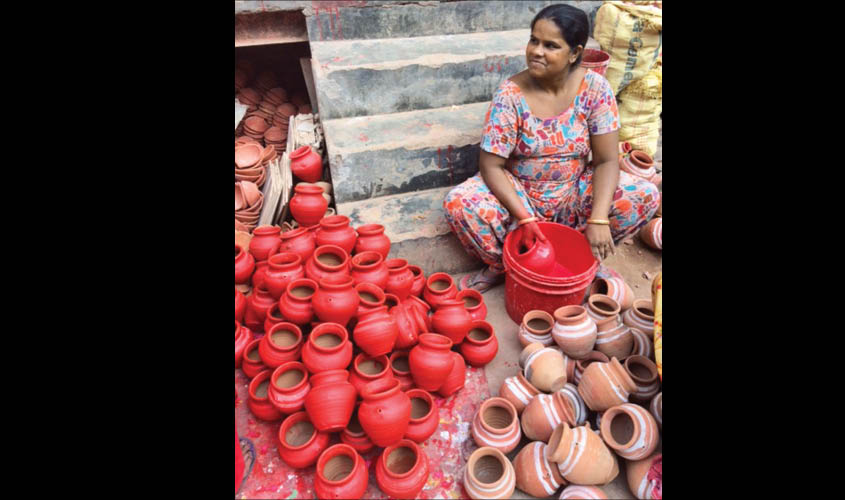Potters in Delhi’s Kumhar Gram are being doubly victimised—by having to sell their products at dirt-cheap rates, and now by the government ban on the use of wood-fire kilns, writes Nibedita Saha.
“It is just not an art, it is our family legacy and I would like to carry this forward,” said Deendyal, one of the youngest potters in Kumhar Gram, India’s largest potters’ colony. This urban village is in Delhi’s Uttam Nagar and it is home to around 400 families that have over multiple generations mastered the craft of pottery.
Every year during Diwali season, Kumhar Gram is abuzz with activity. The potters here are engrossed in last-minute preparations, putting their earthenware and diyas and other products—like sculptures and clay temples—out on display.
Deendyal tells me that he has a master’s degree in history. But his work as a potter hasn’t been affected, for better or for worse, by his education. He grew up in this colony, watching his parents working on the potter’s wheel or the chak. A lack of better career prospects has kept him here. But also his fondness for pottery and his family ties.
“I don’t want to do a Rs 12,000 job. But then pottery work is also not a proper source of income for us,” says Deendyal.
Walking through the potters’ colony, one hears a din of voices—of vendors trying to make a sale and buyers trying to bargain. The potters in Kumhar Gram sell their products at a very low price, mostly in wholesale to dealers who further sell the same products in different parts of the city at higher profit margins.
“I have to sell this kalash for Rs 12-13 but it will be sold for Rs 50 in the market,” Kavita tells us, while colouring a matka that she is now making. “We don’t get proper prices for our products.”
The diyas made in Kumhar Gram are always in high demand in the days leading up to Diwali. Buyers come here from across the NCR, because of the variety of products available here and the dirt-cheap prices they can be bought at. (Small diyas sold here cost as little as a rupee each.)
Ashok, a visitor shopping for diyas and idols of deities, says, “Every year I buy all the necessary pottery products around Diwali here. Because I get a variety of items at the cheapest prices in this market.”
While the affordability factor keeps the footfall high in this market, it is taking a toll on the lives of the potters. Most are facing a severe financial crunch and are struggling to earn even a subsistence income.
“We don’t even get a basic minimum required price for these products, which take a lot of hard work and time on our part,” says Puja, a Kumhar Gram resident who is helping her father complete orders on time.
Puja had to quit her schooling when she was in the ninth standard, owing to “financial crises at home”. “I could not study because my father is the only earning member in my family, and through pottery he can’t feed all of us,” she says.
Rajesh, another resident of the potters’ colony, works in a private company in Gurgaon. He has a similar story to tell: “I work night shifts in office and do the pottery work during daytime around Diwali. We can’t meet our daily expenses only by making pottery.”
Most potters here are feeling the pinch due to competitive pricing and low wholesale rates. But their concerns have been compounded by the government’s push to ban wood-fired kilns used by potters for their work.

“If they close our bhattees, we will be on the road,” says Sri Krishna, who has worked as a potter and lived in this colony for over 60 years. He is among those who have received a government notice demanding that they shut down their kilns right after Diwali.
“I can’t do anything else. Pottery is the only source of income I have. But this might soon be taken away from me. As it is, we have been selling our products at the lowest prices. But if the bhattees get shut, then there will be nothing left for us,” says Sri Krishna.
Bharat Raj has also received the government’s notice. He says, “Electronic bhattees will increase our manufacturing cost. We won’t be able to make any profit if we go for electronic or CNG kilns.”
Kuldeep Singh is a retired CRPF soldier from Rohtak who has taken up pottery work recently and is now based in Kumhar Gram. He says, “People living in this colony have been doing pottery work for generations. It is the main source of income for them. If the bhattees are removed, the whole community will be in trouble.”
Lighting diyas on Diwali is part of our centuries-old heritage. Potters are the reason we are able to keep this tradition alive. If we want to help preserve that tradition down the ages, we need to think about

